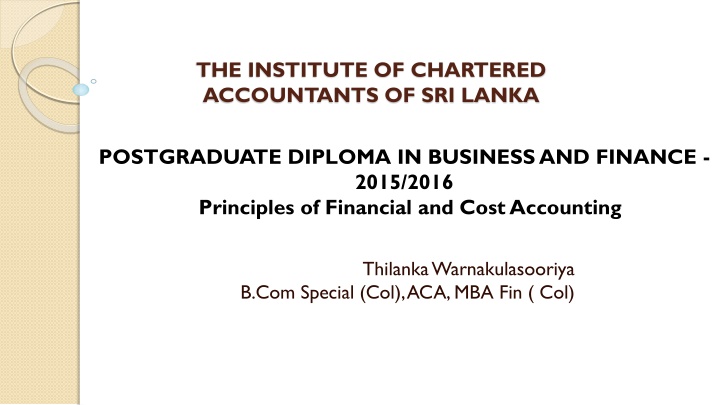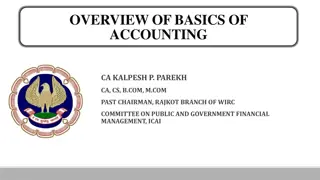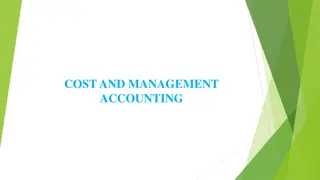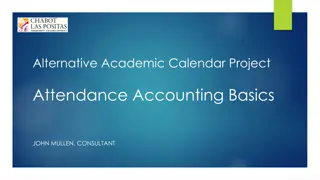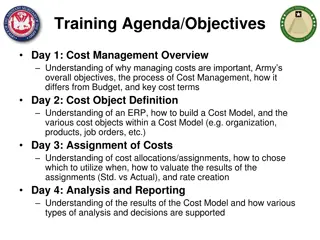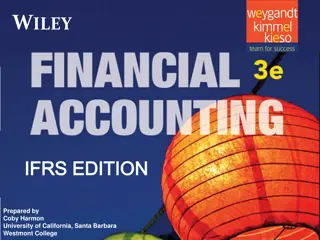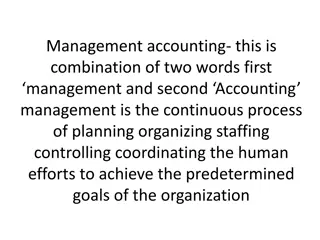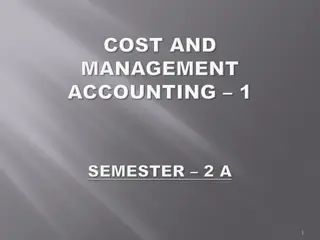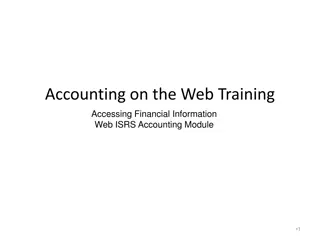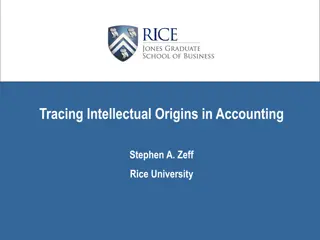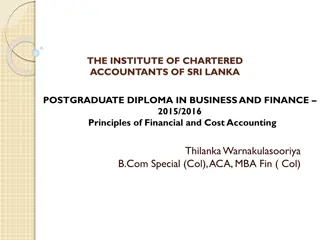Principles of Financial and Cost Accounting
This content covers the principles of financial and cost accounting, focusing on topics such as provisions, contingent liabilities, recognition criteria, obligating events, and calculation of provisions for warranties. It discusses the Institute of Chartered Accountants of Sri Lanka's postgraduate diploma in Business and Finance and provides insights into key accounting concepts.
Download Presentation

Please find below an Image/Link to download the presentation.
The content on the website is provided AS IS for your information and personal use only. It may not be sold, licensed, or shared on other websites without obtaining consent from the author.If you encounter any issues during the download, it is possible that the publisher has removed the file from their server.
You are allowed to download the files provided on this website for personal or commercial use, subject to the condition that they are used lawfully. All files are the property of their respective owners.
The content on the website is provided AS IS for your information and personal use only. It may not be sold, licensed, or shared on other websites without obtaining consent from the author.
E N D
Presentation Transcript
THE INSTITUTE OF CHARTERED ACCOUNTANTS OF SRI LANKA POSTGRADUATE DIPLOMA IN BUSINESS AND FINANCE - 2015/2016 Principles of Financial and Cost Accounting Thilanka Warnakulasooriya B.Com Special (Col), ACA, MBA Fin ( Col)
LKAS 37 Provisions, Contingent Liabilities and Contingent Assets (LKAS 37)
Provision. A liability of uncertain timing or amount. Liability. A present obligation of an entity arising from past events, the settlement of which is expected to result in an outflow of resources embodying economic benefits.
Recognition - Provisions A provision should be recognised when, and only when: An entity has a present legal or constructive obligation to transfer economic benefits as a result of past events; AND It is probable that an outflow of resources embodying economic benefits will be required to settle the obligation; AND A reliable estimate of the obligation can be made.
Obligating event An event that: creates a legal or constructive obligation results in an entity having no realistic alternative but to settle it A legal obligation derives from law (e.g. contract, statute, courts, etc) A constructive obligation derives from actions and creates valid expectation that entity will discharge these obligations. i.e established pattern of past practice, published policies, or a sufficiently specific current statement, the entity has indicated to other (third) parties that it will accept certain responsibilities
i.e Speed Cars Pvt Ltd owns workshop that it uses for servicing cars under warranty. In preparing its financial statements, Company needs to ascertain the provision of warranty that it would be required to provide at year-end. The entity s past experience with warranty claims is 50% of cars sold in a year have zero defects. 30% of cars sold in a year have normal defects. 20% of cars sold in a year have significant defects. The cost of rectifying a normal defect in a car is 20,000. The cost of rectifying a significant defect in car is 50,000. Required Compute the amount of provision for warranty needed year end
Contingent liability. A possible obligation arising from past events whose existence will be confirmed only by the occurrence or nonoccurrence of one or more uncertain future events that are not completely within the control of the entity. A present obligation that arises from past events but is not recognized because either it is not possible to measure the amount of the obligation with sufficient reliability or it is not probable that an outflow of resources will be required to settle the obligation i.e. A penalty that becomes payable in a pending litigation case.
Contingent liabilities are not reflected in FS due to following The probability of outflowing of resources of the entity embodying economic benefits is not certain The Present obligation is not exiting due to the past event and the obligation cant be quantified with sufficient reliability But needs to be disclosed in FS. An estimate of its financial effect An indication of the uncertainties relating to the amount or timing of any outflow The possibility of any reimbursement
Contingent asset A possible asset Arises from past events Whose existence will be confirmed only on the occurrence or non-occurrence of one or more uncertain future events not wholly within the control of the entity.
An enterprise should not recognize contingent assets. Disclose if in flow of benefits probable
Disclosure Provision Full reconciliation and explanation Contingent liability Brief description and estimate Contingent asset The nature and financial effect
